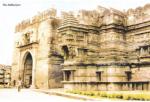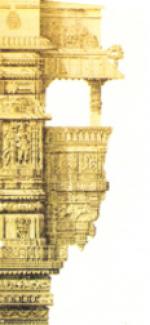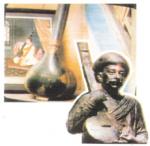To the southeast of Vadodara, about 30 km away is the historical town of Dabhoi. And as we take its name, we cannot but recall the names closely associated with it: the mason Hira and the poet Dayaram.
Dabhoi is also known for its fort made of stone. Situated to the north of the River Narmada, and called Durg Vamavart. It is like a Swastika with four gates for entry. They are also known as Hira Bhagol in the east, Nandori Bhagol in south, Vadodari Bhagol in west and Mahudi Bhagol in the north, named after the nearest noted places from the gates
This fort was constructed in late 12th century after the wars of Chaulukya, Vaghela and Parmar royal families had their wars with the Gujarat, Maharashtra and Malva respectively. It was completed in 13th century. Although it has been repaired and renovated a number of times many of the original elements of its construction can be seen even today. Vishaldev Vaghela of Gujarat played an important part in its construction according to the inscription near the Kalika Mata temple
It is believed that one Hiradhar Shilpi, a mason, was responsible for the repairs of the fort and its gates. The original builder was named as Deva Shilpi. There are 3 Jain temples besides Rishabdev Jaytilakprasad. A small temple of Lord Shiva is at the center of Nageshwar temple and other places of interest include Bibi ni Bagi, a Dargah with minrettes, the later temples of Vaghnath, Mangleshwar, Ashapuri and Gadh Bhavani. The construction and carvings of the four gates are excellent.
Hemchandracharya wrote some part of his Vritti in his Yoga Shastra at this place. In 17th century, the poet Ratno and Dayaram, the poet who created 'garbi' type of poetry lived here. During the Solanki rule, Ulugh Khan, the powerful deputy of Alauddin Khilji destroyed the rich temples here though ruins of the Kalika Mata temple and the Hira Bhagol gate continue to remind us of its former glory, beside a local legend. The fort with 900 m length and 700 m width and with just one gate of it with such intricate and excellent carvings, remind us of this interesting tale. It runs something like this ...
Maharaja Jaysinh was building the fort. The leader of the construction was the skilled mason (kadia) Hira. His beloved was Tenn. She taunted Hira, "If you are doing so much for the State, why don't you make something to remember me by?" And so, Hira began to take away some of the major stones meant for the fort, and kept them a little away from Dabhoi. He built a small lake and named it a the stones, he filled the gaps in the fort with mud. Soon his c The angry ruler punished him by building a wall around him But his friends kept a little hole in that wall for him to bre, feed him from it with 'ghee' she poured into it and kept him alive. The gate was completed. But when the time came to put an arch over it, there was trouble. Nobody could do this construction. No one but Hira knew the foolproof method for it
As the ruler was worried, friends of Hira saw an opportunity. They took the promise from the ruler not to punish Hira once again, and brought him out from the wall. Living once again he constructed this famous and most artistic arch on this gate. It became famous as Hira Bhagol. Hira also constructed a similar arch at Zinzuwada in North Gujarat. But then the fort was razed and a number of sculptures were brought to the ground and went unattended. Yet, even in such a condition of negligence we are amazed to observe its beauty, the skilful construction of Toran, Kaman and Zarukhas.
The famous novelist 'Dhumketu' has recorded the decline of a subjugated people who neglect its cultural heritage in his novel 'Vinipat', and he has made this Hira Bhagol as its central theme. One of its character, an Englishman is historical. Gujarat Govt. has made a film on the story of Hira Kadia.
Dayaram
Dabhoi recalls the revered memory of Dayaram. It was Dayaram who gave the Gujarati woman a kind of poetry that she could sing well. This devotee of Krishna was born at Chandod. His original house is still here. The house next to it displays the main events of his life in pictures. The main crossroads here is decorated with his statue.
However, Dabhoi was the place where he actually worked. The small house where he used to stay at first has also been preserved in his memory. The citizens of Dabhoi have also preserved with great reverence the bigger house into which he shifted later and lived in until his death. The will that he made, his 'tanpura' and his spectacles are all put up in glassed showcases for display. Thus, Dabhoi is our historical place of pilgrimage for it is full of art, grace; culture and literary achievements.









